
archives for 02/2018
I installed an amplified outdoor HDTV antenna
recently and it was easy
to set up.
It has a motor rotor that
allows you to turn the antenna from a remote
control. The extra mounting bracket
and pole are designed to be installed on the side of a building.
The amplifier box has two
outputs so you can hook up an FM radio.
It gives a strong signal. I haven't tried TV over the air since back
before the days of digital and was surprised to find out the local PBS
station has 3 channels.
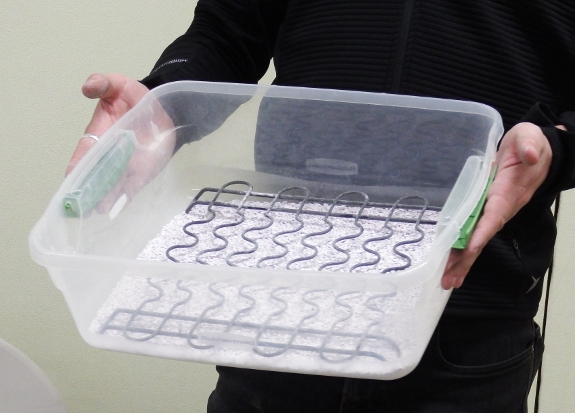
While sorting seeds in
preparation for our spring seed order, I remembered some pointers from
the recent seed-saving
workshop that I'd forgotten to share here. Dr. Brian Pace from Ohio
State University showed off his seed-storage box and method, which are
subtly better than my own.
Inside his box, Dr. Pace
adds a healthy helping of Drierite beneath a metal stand to
suck up moisture in the air without directly impacting the seeds
themselves. Meanwhile, he uses a simple formula to see if the spot
where he's storing his seeds is effective:
In other words, if you
live in the humid south and your storage spot hovers around 60%
humidity, you need to lower the temperature to around 40 in order to
keep seeds fresh.
While you're at it,
don't forget to keep an eye on average
seed longevity. No
matter how fancy your seed-storage arrangement, it's not going to keep
the lightweights --- corn, onions, parsley, peppers --- for more than
two years. Good luck and have fun as you put those first dormant
embryos into the ground!
 Have you been looking for a
platform? If so, you're in luck.
Have you been looking for a
platform? If so, you're in luck.
We've just revamped our Avian Aqua Miser website to
be an information clearinghouse and are seeking guest bloggers to share
their poultry-related insights there.
Why might you want to
blog with us? We haven't been making
regular posts on Avian Aqua Miser for two years, but the site still
hosts about 10,000 visitors per month. Now that Avian Aqua Miser is
mobile friendly and will be seeing a lot more new content, I expect our
viewership to soar.
"That sounds like fun!"
you might be thinking. "How do I sign up?"
Just email mrlocalmusic@yahoo.com with:
- A sample guest post based on these guidelines (but chicken-related, please!)
- A paragraph about why you'd like to blog with us
- How often do you plan to make a post?
- Do you know how to use Wordpress?
We're only going to
choose a few guest bloggers because we want to keep the quality high,
so please don't be distressed if your application doesn't make the cut.
And, if you're not interested in guest posting but are interested in
chickens, I hope you'll check out the new site as it gradually comes
back from the dead.
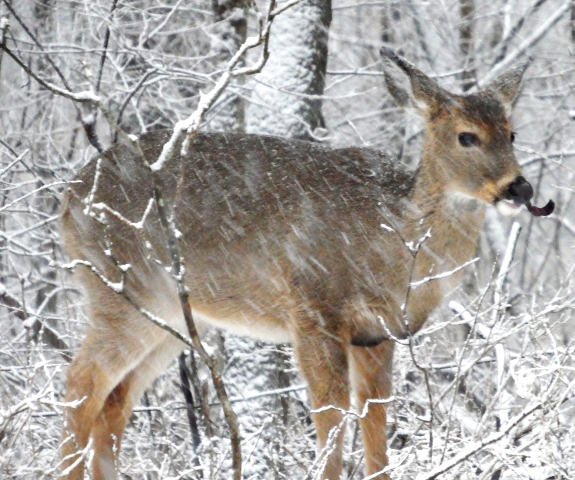
Our new core homestead
is very
rich in honey locusts.
Despite the fact that our septic crew cleared several away while moving
the trailer in, just as many big trees are left, and I suspect autumn
will continue to see the ground covered in these big pods for the
foreseeable future.
Books tell me that livestock and even
Native Americans relished the sweet pod insides. And yet, they sat untouched
on our ground through November and December and January.
It took a February snow to prove that somebody finds them tasty. Sunday
morning, a herd of deer moved through, carefully picking pod after pod
off the ground. I guess the wildlife were just saving honey locusts for
a midwinter treat.
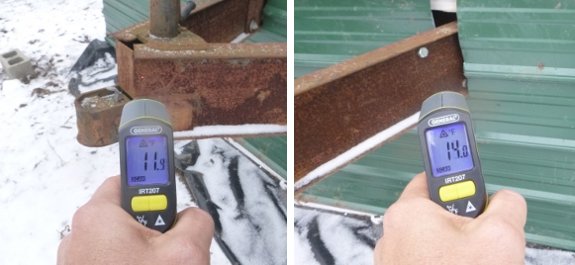
There might be some level of heat
sinking going on with our trailer towing tongue.
The far end is a little bit
colder than 2 feet over.
The outside temperature was
24 degrees while it was 54 inside.
I'm curiouis now if the
temperature difference would be the same this Summer?
Maybe expelling heat in the Summer will balance the loss of heat during
the Winter?
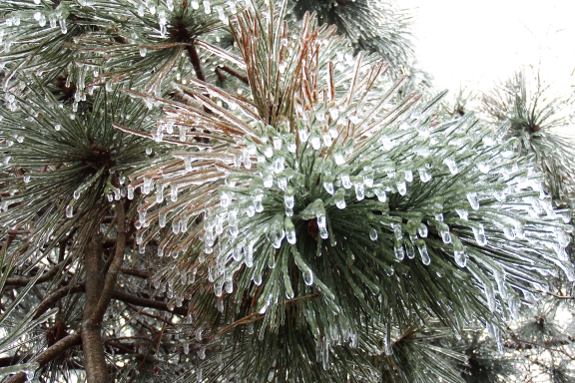
I love snow and ice and
winter...and this move north has given me lots
of each to apreciate.
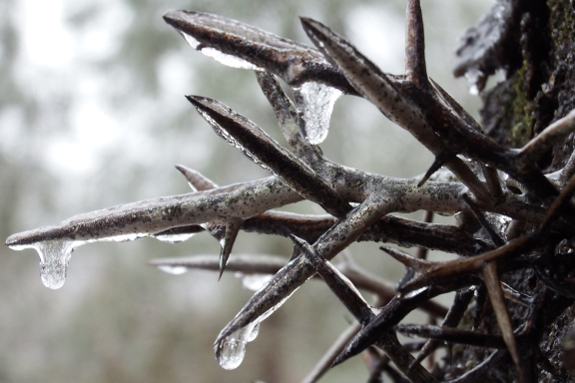
This week, it's an
up-close-and-personal invitation to dance amid rime.
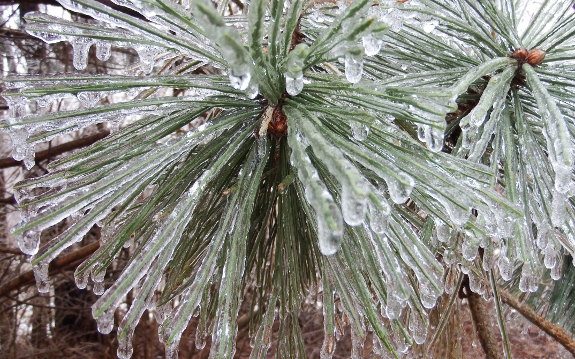
On the downside, rime
coats our antenna and takes down the internet. So please excuse us if
you can't call or email until the sun comes back out!
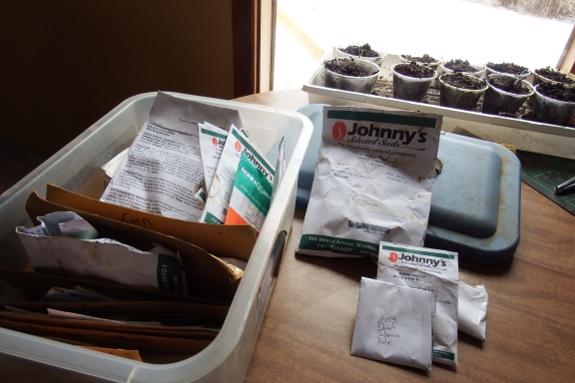
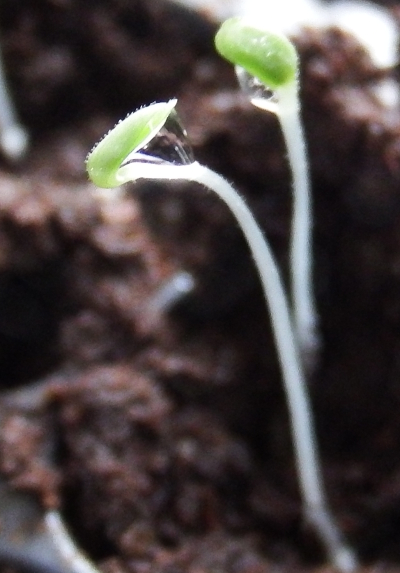 Before the seed order comes
the seed test to determine whether older packets still contain intact
propagules. I ran
some germination tests the usual way, but I went ahead and put
herbs, kale, and lettuce in a flat for their trial.
Before the seed order comes
the seed test to determine whether older packets still contain intact
propagules. I ran
some germination tests the usual way, but I went ahead and put
herbs, kale, and lettuce in a flat for their trial.
I figured these guys
could be set out starting about a month from now under quick hoops ---
not so long to nurture tender seedlings indoors.
Sure enough, the lettuce
passed with flying colors (72% germination --- not bad for uncontrolled conditions in a flat) and were potted up into little plastic cups
five days after the test began. I'm still waiting on the slower
sprouters --- they get one more week to attempt germination before I
order replacements through the mail.
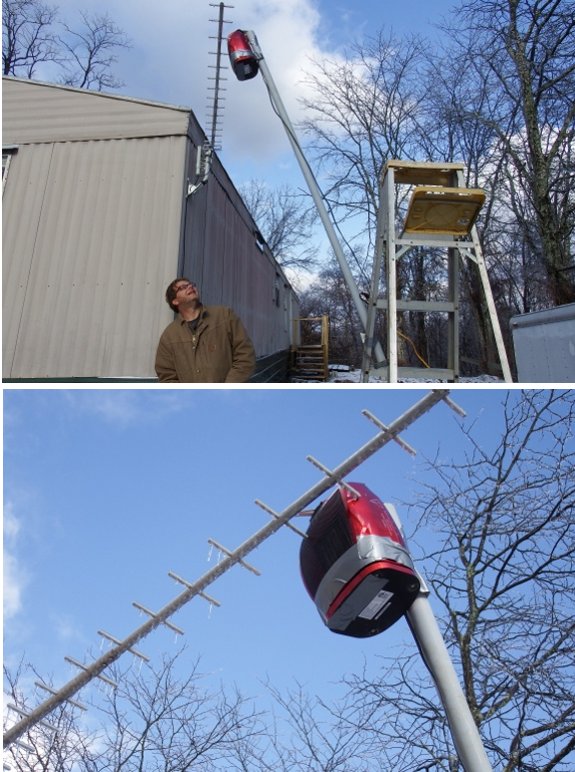
Turns out the rime is robust
enough to block the signal on our WISP antenna.
After a full day and night of
no internet I dreamed up a space heater on a 10 foot conduit pole.
It only needed a small
section to melt before the signal came back.
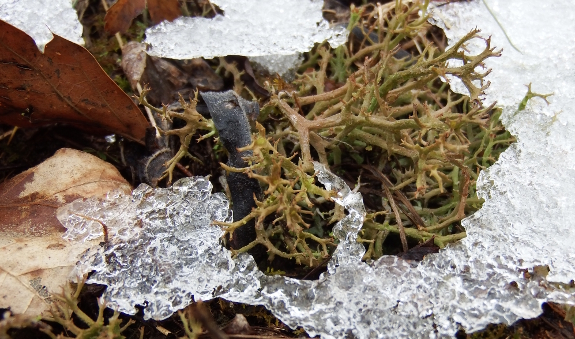
I haven't been regaling
our blog readers with the fun activities we've taken advantage of
recently, which doesn't mean we haven't been enjoying ourselves. Every
Sunday, Mark and I are hitting each other with swords at fencing class.
We visited (and learned about) the local Grange last week. And, on
Saturday, Jenn met
me at Burr Oak State Park for their annual winter hike event.

I was astonished by the
turnout --- literally hundreds of people spread across four hikes. Jenn
and I chose the five-miler and hung back so I could snag photos of
beauties along the trail.
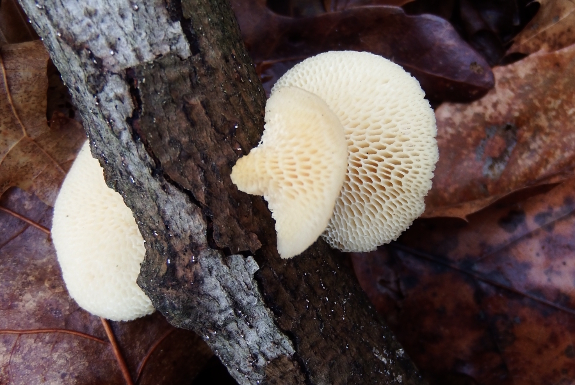
We also got to talk to
one of the Buckeye Trail Association volunteers while we walked. He's
been experimenting with growing things on reclaimed strip mine land for
the last seven years and I'm hoping to tease a guest post out of him on
the subject. So stay tuned!
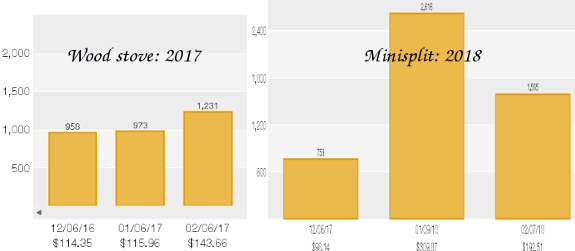
Well, we definitely
can't report on the air-conditioning aspects yet, but I can give you a
rundown on our minisplit's ability to keep our trailer warm. The really
short version --- it works well until exterior temperatures get down
into the single digits, but it's pretty pricey to operate.
The image at the top of
this post shows three months of energy usage from last winter (a
slightly warmer climate, but not by much, heating primarily with a wood
stove) and this winter (in which the minisplit went into operation
partway through the first month on the graph). The lower energy usage
for the third month of this year is because I had so much sticker shock
at a $300 electric bill that I kept the interior temperature around 58
to 60 most of the time during January.
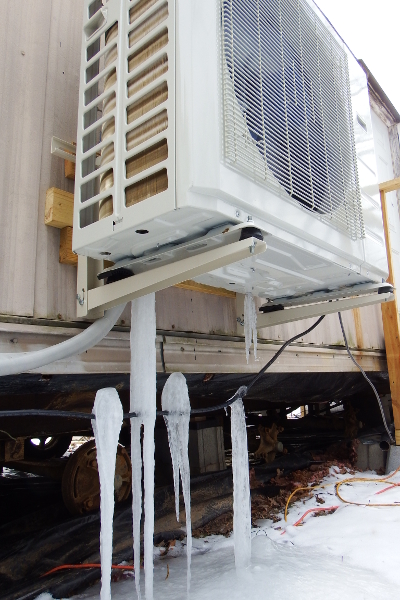 Other than energy usage, I
only have a few things to report about the minisplit. Mostly it just
runs --- yay! We're extremely glad we mounted it on the wall rather
than on a pad on the ground because the defrost function creates huge
icicles below it during frigid weather. (The photo here is only the
barest edge of what happened later in the month, which I thought I'd
photographed but apparently hadn't.) I'm not sure how even a
well-drained, ground-mounted unit could keep going in the face of so
much ice.
Other than energy usage, I
only have a few things to report about the minisplit. Mostly it just
runs --- yay! We're extremely glad we mounted it on the wall rather
than on a pad on the ground because the defrost function creates huge
icicles below it during frigid weather. (The photo here is only the
barest edge of what happened later in the month, which I thought I'd
photographed but apparently hadn't.) I'm not sure how even a
well-drained, ground-mounted unit could keep going in the face of so
much ice.
The thermostat on our
particular unit is pretty terrible. The colder it gets outside, the
less realistic the temperature we set on the unit is (as measured by a
thermometer placed only a few feet away from the remote, which is where
the minisplit measures air temperature). The settings also only go down
to 62, which is a shame --- I'd really like a spot between that and off
to use at night.
In terms of sound ---
the minisplit is remarkably quiet. Now and then when ice is building up
on the blade, you'll hear it more than usual for a few minutes. But,
usually, it's a very dull hum from inside the trailer ---
non-noticeable.
In the end, we're very
glad we have an easy, moderately efficient electric option, but all
electric heat sources are still energy- and money-intensive. We're
looking forward to
installing our wood stove before next winter, at which point I suspect
we'll move to using the minisplit about half as much as we currently do.
We tapped our first Sugar
Maple tree in Ohio today.
The same fancy
stainless steel spile we
used before.
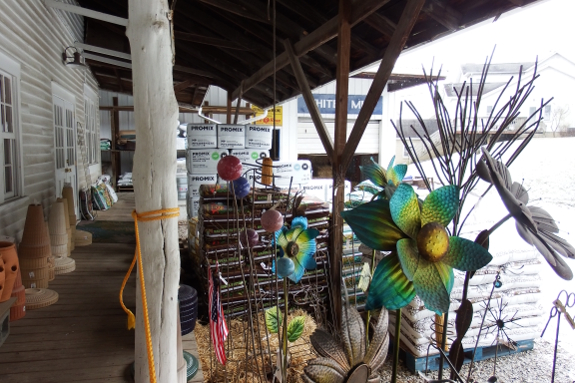
It can be so tricky to
buy potting soil off the shelf. All of the bags are covered with pretty
printing...with no truth windows to show off the quality of the product
inside.
The brands you can get
at the big-box stores are notoriously hit or miss in quality. So I was
thrilled to find high quality garden amendments of all types at White's Mill on the other side of town.
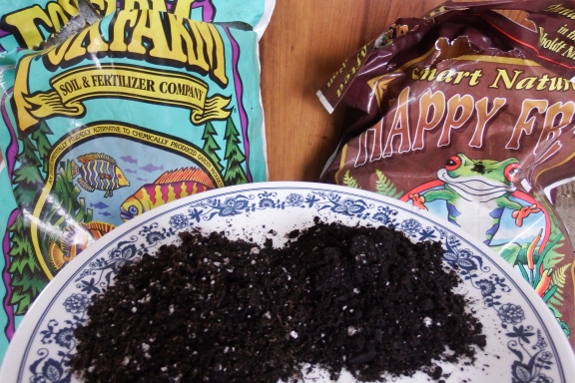
I splurged on small bags
of two different brands to get an idea of their quality before making a
larger commitment. At home, I pulled out a handful of each and was
quite pleased with the texture and moisture level of both Fox
Farm and Happy
Frog. (I was even
more pleased to discover that White's Mill's prices are less than half
of what's listed on Amazon.)
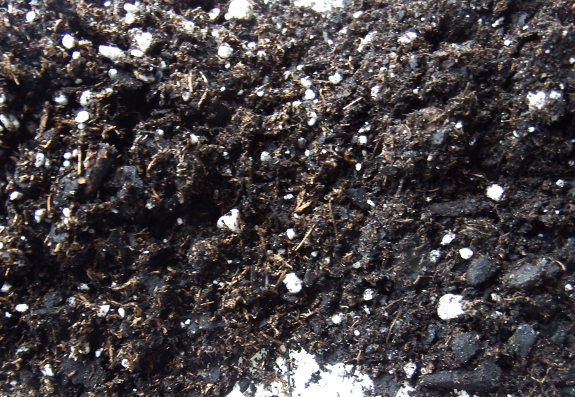
Here's a closeup view of
the two soils side by side. Pretty similar! I potted up four lettuce
seedlings into each type of soil and will report back if I see a
difference in growth. But, at the moment, I'm guessing it would be hard
to go wrong with either product.
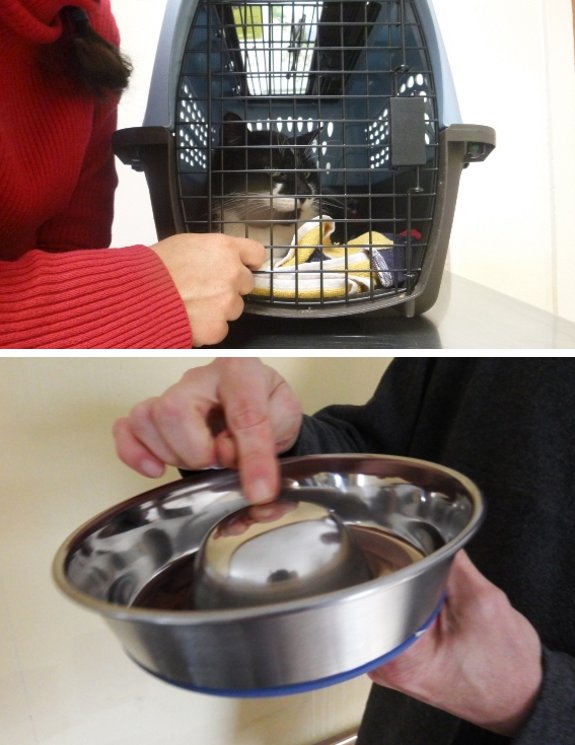
Huckleberry was having some trouble keeping his food down. His new cat doctor suggested he was eating too fast and recommended a slow feed pet dish to discourage rapid eating.
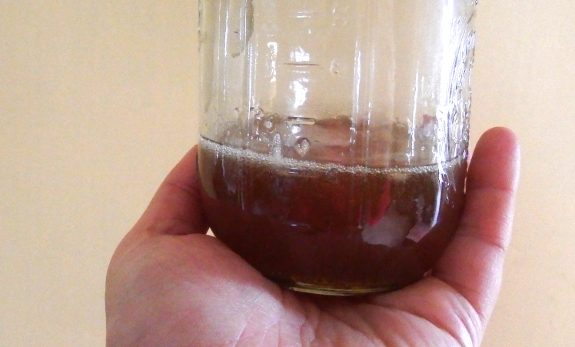
We picked just the right
time to tap
the sugar maple just outside our back door. Twenty-four hours
later, the two-gallon bucket was nearly full!
When tapping in
Virginia, I couldn't taste any sweetness in our maple sap, but here the
sugars are more condensed and are evident even in liquid straight from
the tree. After boiling down a gallon and a half of sap, we ended up
with half a cup of quality maple syrup. Just in time for Mark's weekend
pancakes!
We finally found a good used
truck on Craig's list that was not too far away.
It's a 1997 Ford F-150 with
122k miles.
Big thanks to our neighbor
Tony for helping to evaluate the road worthiness and to test out the 4
wheel drive. It was his idea to counter offer 2500. It has a little
surface rust and the AC stopped working but has some new parts along
with new tires.
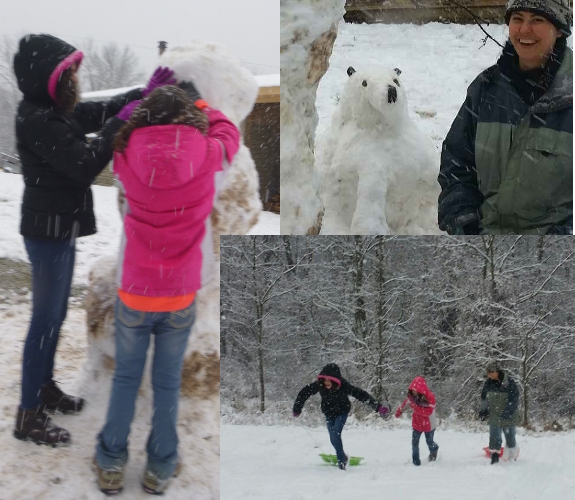
I've been waiting and
waiting for the perfect packing snow all winter. Finally, it fell!
So I borrowed the
neighbor kids for sledding, snow-man (and -dog) building, and (their
top choice) ornamental snow-cupcake creating. Despite being slightly
derailed by a snowball fight, fun was had by all for the cheap price of
a carrot (for a snow man) and a brownie (for the kid whose nose was hit
by a snowball).
If spring absolutely
must come, I'm now ready. I wouldn't mind another few white-outs in the
interim though....
Our first experience at using a floor leveling compound went better than expected.
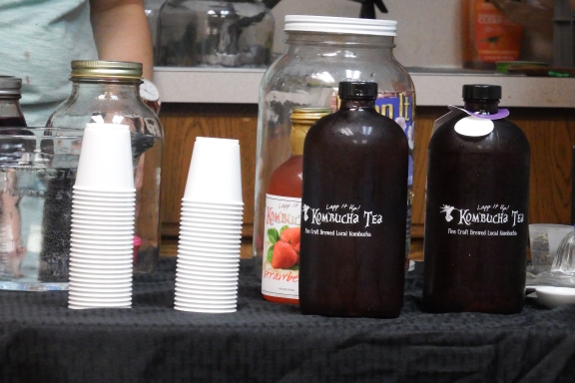
Mark and I enjoyed a
class on kombucha (fermented sweet tea) and kvas (fermented, salted
beets) on Tuesday. I'm not going to try to sum up every little detail
because the internet is full of how-to posts. Instead, I'll just hit
the highlights here.
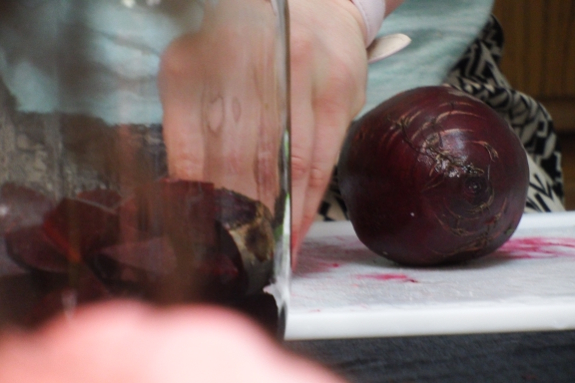
I'll start with kvas,
the much less well-known beverage. Our instructors washed and cubed
raw, unpeeled beets and filled a glass gallon jar about halfway with
the vegetables. One tablespoon of non-iodized salt plus a quart or two
of unchlorinated water finished the preparation. After that, they let
the crock ferment at room temperature for two to five days then sit in
the fridge for another week to intensify the flavor.
Kvas is meant to be
drunk in small doses to cleanse the liver. The result is something for which I've not yet acquired the taste (although I don't really like beets or salt,
so take that with a grain of, well, salt). Actually, the more
interesting point came from my seat mate, who told me she made a
sweetened beet pie seasoned with lemon zest last year --- now that might be worth a try.
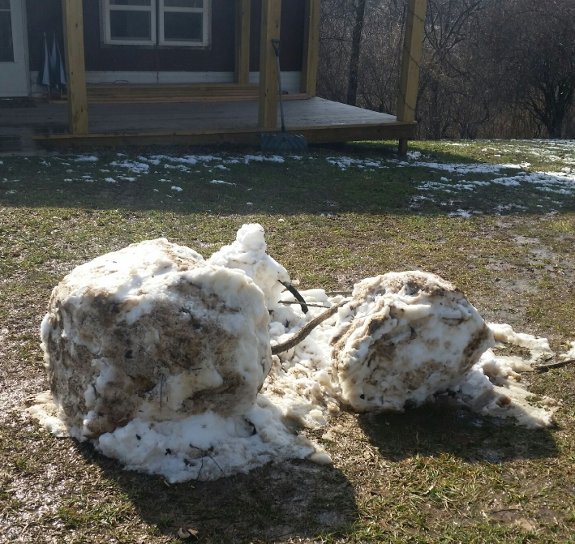
Anna's recent snowperson had a fatal disagreement with the sun the next day.
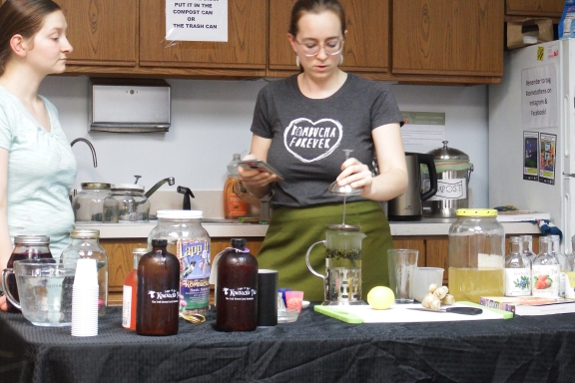
While I wasn't a huge
fan of the kvas at Tuesday's workshop, the
kombucha was definitely tastier. And no wonder since the
teachers make the fermented sweet tea professionally to sell at several
local establishments.
I've actually steered
clear of kombucha in the past for two reasons --- sugar and caffeine.
If you're a soda drinker already, kombucha is a healthier alternative.
But the happy gut critters didn't seem like a good enough reason to let
the less healthy chemicals that come with them into my life. So I was
happy to learn that you can actually make a caffeine-free kombucha
using rooibos (aka African redbush) tea. The sugar, I'm afraid, is
still mandatory.
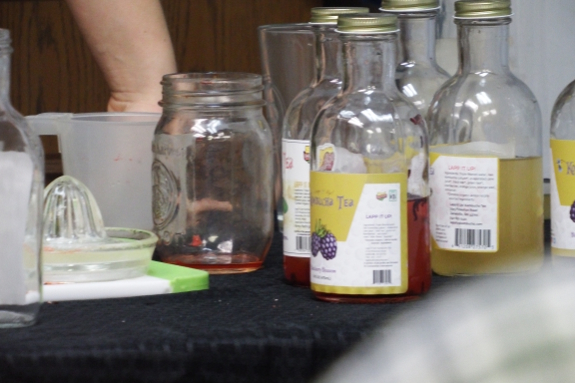
My other big takeaway
from the class is that kombucha doesn't have to taste bad for
ferment-o-phobes like me. The teachers passed out several samples, all
made by fermenting kombucha normally then adding in fruit or herbs
before sealing the bottle for two to three additional days. Mark was a
big fan of the jasmine green tea with concord grapes, which I thought
tasted a little like red wine. I, on the other hand, enjoyed the lemon
ginger, which tasted like a high-class lemonaid.
Will we be making our
own kombucha? The jury's still out. But we might try buying a bottle
now and then at the farmer's market while making up our minds.
I chose the 1
gallon Helix drill attahment mixer over the 5 gallon option.
Even with the motorized help
it was still a good workout for the wrist.
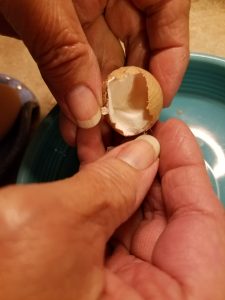 You may recall that I
put out a call for chicken posts a few weeks ago. I've been
astonished by the fun and educational posts that came filtering in
afterwards! Here are a few of my favorites, but you might want to go
poke around on our chicken blog to dive deeper into this new
sharing of wisdom:
You may recall that I
put out a call for chicken posts a few weeks ago. I've been
astonished by the fun and educational posts that came filtering in
afterwards! Here are a few of my favorites, but you might want to go
poke around on our chicken blog to dive deeper into this new
sharing of wisdom:
Jayne posted about fairy eggs --- tiny eggs that showed up
as her flock began to lay after a long winter without.
Jeremy regaled us with the
whys and hows of chicken dust baths --- the way poultry get
clean by rubbing themselves with dirt.
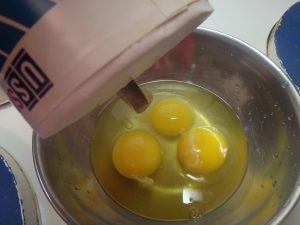 And Kayla
provided tips on freezing eggs to fill in that long winter gap.
And Kayla
provided tips on freezing eggs to fill in that long winter gap.
Do you have a
chicken-related story to share? Email it over to aimee@wetknee.com and
it might just show up on the blog.
Happy chicken keeping!
We tried a set of off market 18 volt replacement batteries
back in November.
They work good but the fit is
a little tight.
Some sanding of the plastic
can decrease the chance of it sticking.
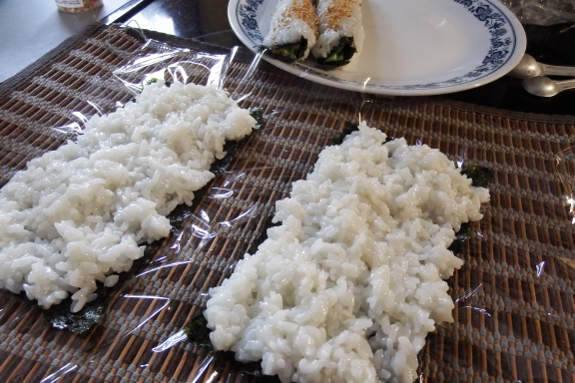
I don't like rice or
fish or, well, probably seaweed. But I learned on our honeymoon that I
love sushi! Too bad the good stuff is so darned expensive....
"You know, we could make
that," Mark said after bringing me home sushi as a treat for the fifth
time in a row. And he was right.
I totally bombed the
first batch, but the second was so tasty it was hard not to eat it one
one gulp. Here are the ingredients for making four California rolls:
- 1 cup uncooked sushi rice (be sure to rinse the raw grains five times before cooking according to the instructions on the bag in a rice cooker or instant pot)
Sauce to add to cooked
rice:
- 2 tablespoons rice vinegar
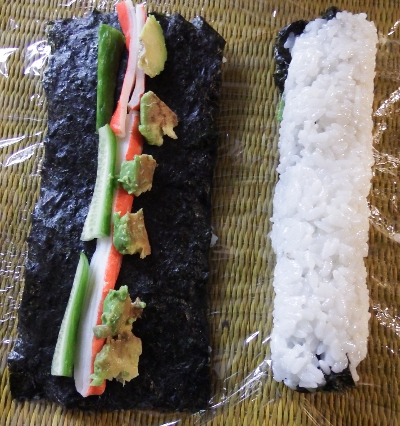 1 tablespoon sugar
1 tablespoon sugar- 1/2 teaspoon salt
- 1.5 teaspoons sake
Add the following while
assembling the California roll:
- 2 sheets of nori (each one broken in half)
- 1/2 of a small cucumber
- a bit of imitation crab
- 1/4 of a ripe avocado
- 4 tablespoons of toasted sesame seeds (to sprinkle on the outside)
I'll let you search the
internet for assembly instructions. It's all about temperature of the
rice, a piece of saran wrap for rolling (wasteful, I know!), and
keeping the filling very small.
You'll notice I didn't take
any pictures of the cut rolls, though. I'm still figuring out how to
slice my masterpiece without knocking it out of shape. Maybe some sushi
experts out there will comment with their tips?
Want more in-depth information? Browse through our books.
Or explore more posts by date or by subject.
About us: Anna Hess and Mark Hamilton spent over a decade living self-sufficiently in the mountains of Virginia before moving north to start over from scratch in the foothills of Ohio. They've experimented with permaculture, no-till gardening, trailersteading, home-based microbusinesses and much more, writing about their adventures in both blogs and books.
